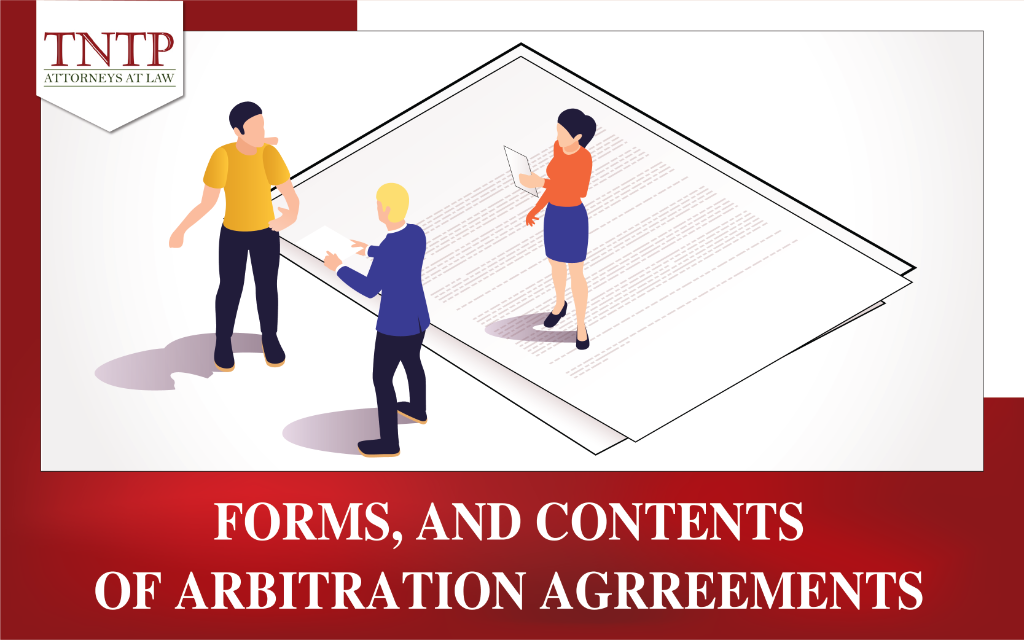The form and content of the arbitration agreement

Resolving disputes through commercial arbitration has become increasingly popular among businesses because of the advantages of this method. One of the critical conditions for a dispute to be resolved by arbitration is the existence of an arbitration agreement between the parties. So, what should parties consider regarding the form and content of the arbitration agreement to ensure its validity? In this article, we will analyze the key points businesses need to pay attention to when drafting an arbitration agreement.
1. Conditions for dispute resolution by arbitration
According to Clause 2 of Article 3 of the 2010 Commercial Arbitration Law, an arbitration agreement is an agreement between the parties regarding the resolution of disputes that may arise or have arisen by arbitration.
As stipulated in Article 5 of the 2010 Commercial Arbitration Law, a dispute shall be resolved by arbitration if there is an arbitration agreement between the parties. The arbitration agreement may be made before or after the dispute arises. If one of the parties to the arbitration agreement is an individual who dies or loses the capacity to perform civil acts, the arbitration agreement remains effective for the heirs or legal representatives of that person, unless otherwise agreed by the parties. In the case where one of the parties to the arbitration agreement is an organization that must cease operations, is bankrupt, dissolved, merged, consolidated, divided, split up or reorganized, the arbitration agreement remains effective for the organization that receives the rights and obligations of that organization unless otherwise agreed by the parties.
2. The form of the arbitration agreement
As per Article 16 of the 2010 Commercial Arbitration Law, a legal arbitration agreement must be established in written form, which can be as a commercial arbitration clause within a contract or as a separate agreement. The following forms of agreement are also considered to be established in writing:
• An agreement established through exchanges between parties by telegram, fax, telex, email, and other forms as prescribed by law;
• An agreement established through written communication exchanges between the parties;
• An agreement recorded in writing by a lawyer, notary public, or an authorized organization upon the request of the parties;
• In transactions where parties refer to a document that contains an arbitration agreement, such as a contract, document, company charter, and other similar documents;
• Through exchanges of petitions and self-defense statements which reflects the existence of an agreement proposed by one party and not denied by the other.
3. The content of the arbitration agreement
Parties can agree to resolve disputes through ad hoc arbitration or an arbitration center. In the case of dispute resolution through ad hoc arbitration, the parties need to specifically agree on the procedures and processes for dispute resolution. If the parties do not agree or the agreement is unclear, legal provisions will be applied to resolve the dispute.
If choosing to resolve disputes at an arbitration centre, parties may refer to the following clause: “Any dispute arising out of or in relation with this contract shall be resolved by arbitration at … in accordance with its Rules of Arbitration.”
Parties may stipulate the following contents in the arbitration agreement:
• The number of arbitrators is one or more (the number of arbitrators must be odd);
• The place of the arbitration shall be (city and/or country);
• The governing law of the contract shall be the substantive law of (for disputes which involve a foreign element);
• The language of arbitration (for disputes which involve a foreign element or disputes in which at least one party is an enterprise with foreign investment capital).
This article by TNTP discusses “The form and content of the arbitration agreement”. It is hoped that this article provides value to businesses and organizations in complying with the law and resolving disputes.
Best regard,



